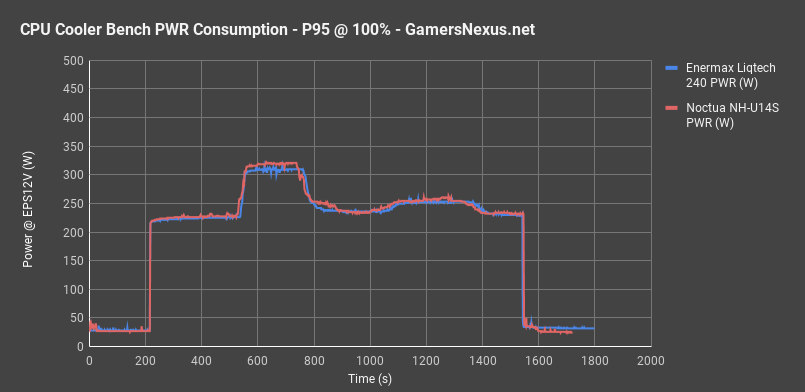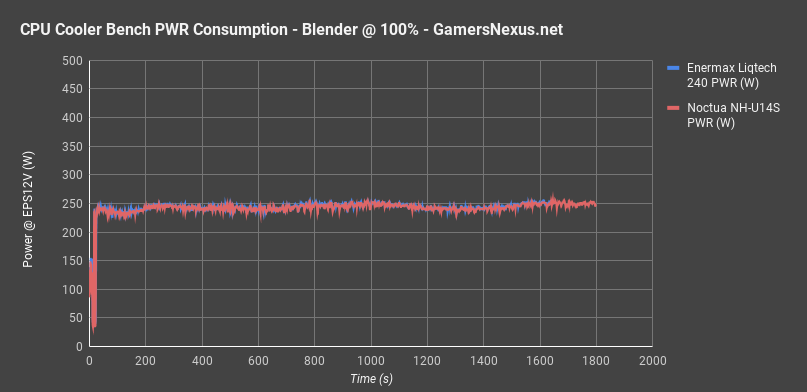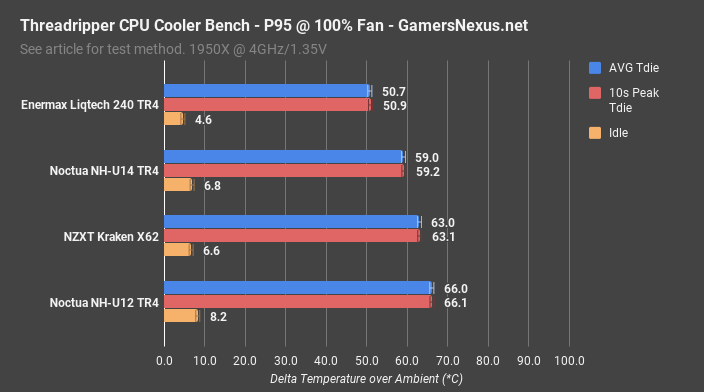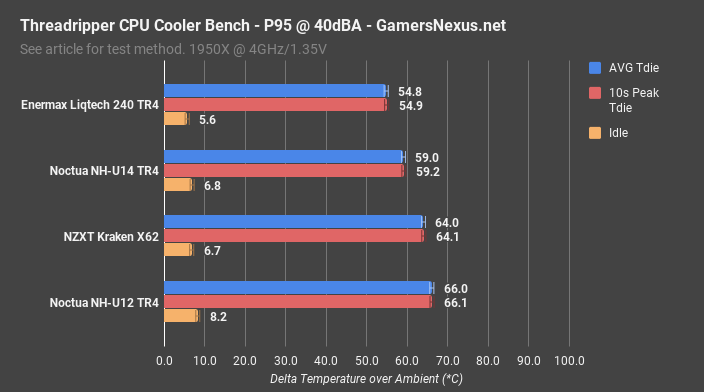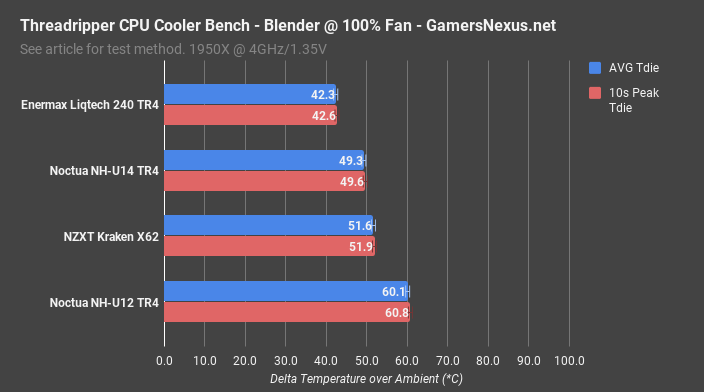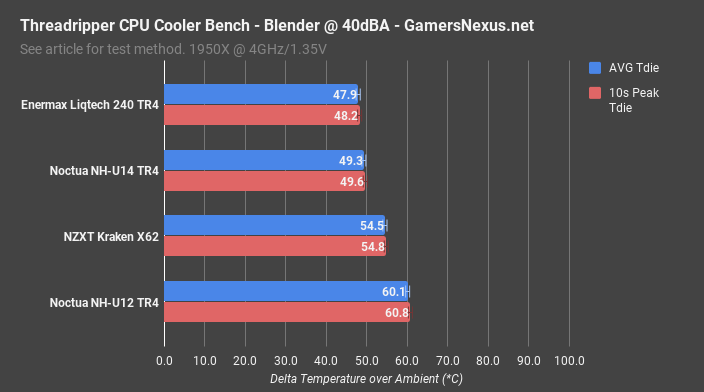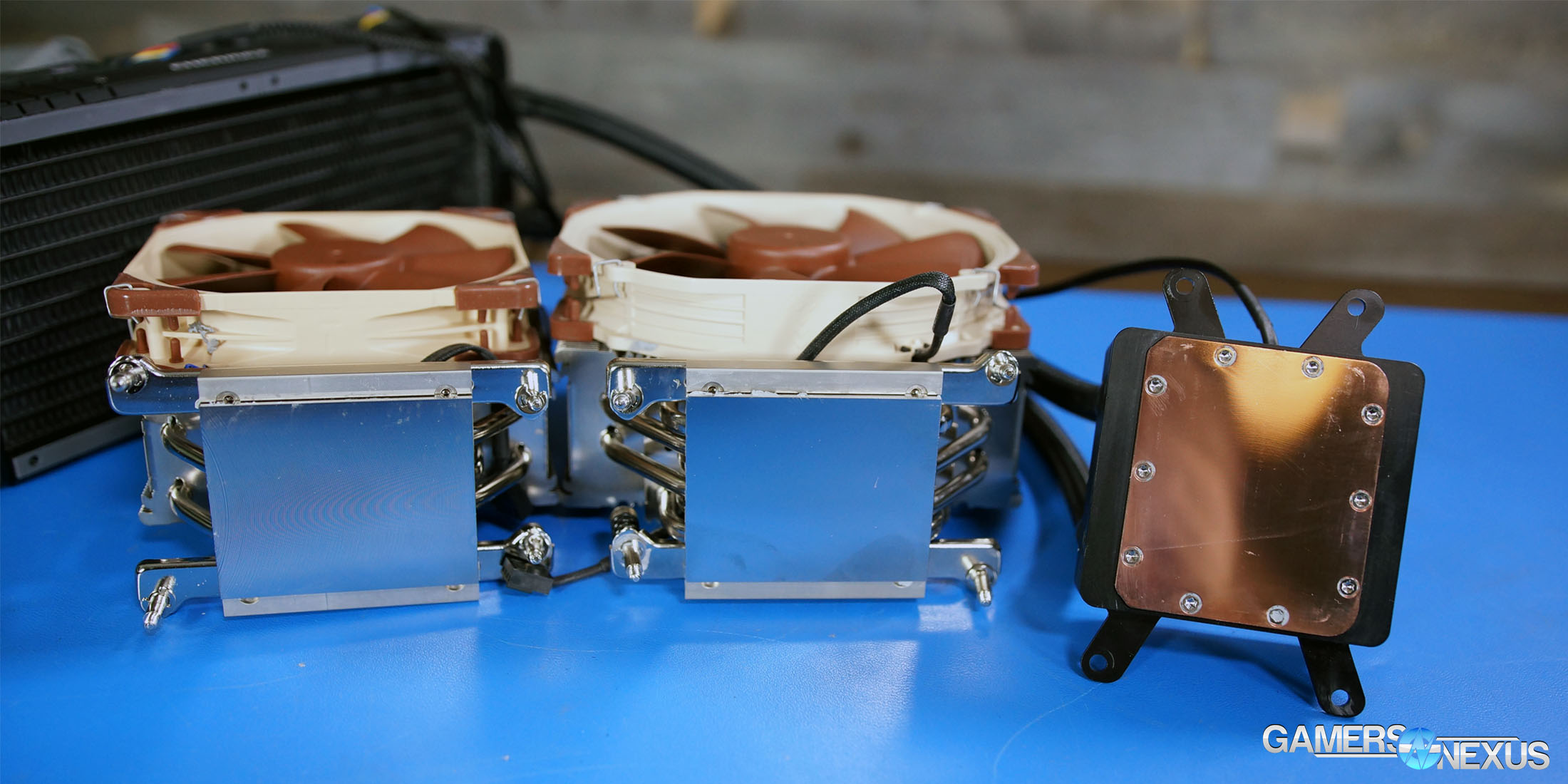Noctua NH-U14S Air vs. Enermax Liqtech 240 Liquid Cooler for Threadripper
Posted on
This testing kicked-off because we questioned the validity of some cooler testing results that we saw online. We previously tested two mostly identical Noctua air coolers against one another on Threadripper – one cooler had a TR4-sized plate, the other had an AM-sized plate – and saw differences upwards of 10 degrees Celsius. That said, until now, we hadn’t tested those Threadripper-specific CPU coolers versus liquid coolers, specifically including CLCs/AIOs with large coldplates.
The Enermax Liqtech 240 TR4 closed-loop liquid cooler arrived recently, marking the arrival of our first large coldplate liquid cooler for Threadripper. The Enermax Liqtech 240 TR4 unit will make for a more suitable air vs. liquid comparison versus the Noctua NH-U14S TR4 unit and, although liquid is objectively better at moving heat around, there’s still a major argument on the front of fans and noise. Our testing includes the usual flat-out performance test and 40dBA noise-normalized benchmarking, which matches the NH-U14S, NH-U12S, NZXT Kraken X62 (small coldplate), and Enermax Liqtech 240 at 40dBA for each.
This test will benchmark the Noctua NH-U14S TR4-SP3 and NH-U12S TR4-SP3 air coolers versus the Enermax Liqtech 240 TR4 & NZXT Kraken X62.
The units tested for today include:
- NZXT Kraken X62 (Asetek, smaller coldplate)
- Enermax Liqtech 240 TR4 (larger coldplate)
- Noctua NH-U14S TR4-SP3
- Noctua NH-U12S TR4-SP3
For full reviews of more “standard” coolers (Asetek/CoolIT sized coldplates for Intel), check our latest EVGA CLC 240 review to get a listing of all the CLCs we’ve reviewed.
As for prices, the Kraken X62 generally retails at around $150-$160 (MSRP), the Enermax Liqtech 240 TR4 unit has an MSRP of $130 (Amazon’s prices may be different, obviously), and the Noctua NH-U14S is priced around $80, with the 120mm variant (NH-U12S) at around $70.
“X is Better Than Y”
The usual mode of content consumption enables readers and viewers to jump to a chart, ignore the surrounding words, and repeat those numbers as hard fact. Unfortunately, the side effect is that this begins to lose focus of the original research, and ends up with somewhat unacademic “air is better than liquid” arguments online. The fact of the matter is, objectively, that liquid+air cooling in a like-for-like test is going to outperform air-only cooling. That’s just science. What matters is things like coldplate size and contact area (something we lose with the Asetek CLCs) and fan quality/efficacy.
What also matters is how we define “better.” There are a few definitions, by our standards:
- Better price to performance
- Better noise-normalized performance (e.g. efficiency vs. noise)
- Sub-category: Acoustic performance
- Better flat-out performance (max RPMs)
Flat-out performance is nice to allow differences to emerge with the greatest degree of separation, but also isn’t necessarily realistic. That’s why we noise normalize at 40dBA when running cooler tests, as it allows us to determine which item is superior under equal acoustic conditions.
CPU Cooler Testing Methodology
CPU cooler testing is conducted using the bench defined below. We use a bench that is more carefully crafted for noise performance, opting for a passively cooled PSU and 23% RPM 980 Ti blower fan for very low system noise. A passive toggle is used on the PSU during noise testing, and the COV fan is disconnected.
No open bench fans are used for these CPU cooler tests. Only fans which are provided with the cooler are used.
| GN Test Bench 2015 | Name | Courtesy Of |
| Video Card | GTX 980 Ti Reference 23% RPM | NVIDIA |
| CPU | AMD Threadripper 1950X 4.0GHz 1.35V | AMD |
| Memory | GSkill Trident Z RGB 3200MHz 32GB | GSkill |
| Motherboard | ASUS X399 Zenith Extreme | ASUS |
| Power Supply | SeaSonic 1000W Prime | Intel |
| SSD | WD Blue SSD | GamersNexus |
| Case | Top Deck Tech Station | GamersNexus |
| CPU Cooler | This is what we're testing! | - |
Our testing for Threadripper CPU coolers is only slightly different from our usual thermal testing on Intel liquid coolers. We’ve improved our means of data analytics by modifying how the data is averaged and sorted in spreadsheets, so that’s new, and we’re also using different monitoring software that works better with AMD products.
Part of this testing also includes new load level tests: (1) Prime95 is used in a scripted torture execution, as usual, and (2) Blender is used for a lower thermal load test.
During both tests, we clamp EPS12V cables and log power consumption actively, which allows us to plot second-to-second draw and validate that our software is generating an equal amount of load for each test pass. This is important, as load cycling in software can completely invalidate results (e.g. spiking power consumption by 30W), but you’d never know that it happened without power consumption statistics.
As usual, we are also monitoring ambient second-to-second with a thermocouple, then using that to create a delta temperature profile (over ambient) for our results, matched versus Tdie in HWiNFO64. Ambient is controlled and monitored during testing. Conducting thermal tests requires careful measurement of temperatures in the surrounding environment. We control for ambient by constantly measuring temperatures with K-Type thermocouples and infrared readers. Two K-Type thermocouples are deployed around the test bench: One (T1) above the bench, out of airflow channels, and one (T2) approximately 2-3" in front of the cooler's intake fan. These two data points are averaged in a spreadsheet, creating a T3 value that is subtracted second-to-second from our AIDA64 logging of the CPU cores.
In our data sheets, we are sorting the power cycles such that the heaviest, enduring load cycle is selected for data (ignoring any potential outlier peaks). We are also creating an averaged 10-second peak load temperature metric; although this metric hasn’t proven useful yet, we hope that it might for products which behave with less consistency.
We are using the AMD Threadripper 1950X CPU at 4.0GHz and 1.34Vcore, configured on the ASUS Zenith Extreme motherboard. We are using the same thermal compound for all tests, applying it with a graduated syringe and manual spreading method. This ensures consistency.
Power Consumption Validation
To address the first concern of outputting roughly equal power between tests, we clamped the EPS12V cables during all tests for all coolers, then compared power consumption between runs. Prime95 load cycles at somewhat predictable intervals, shown in this over time chart, and we can synchronize our data averaging to only pull data from the peak cycle. The heaviest power cycle produces the most heat, as you’d expect, so we’re averaging from that height. As seen in the chart, the tests align well from pass to pass, validating that our testing was conducted under the same power load. There is some variance, and you should also expect to see about a 4% power consumption reduction from leakage for every 10C the CPU drops, but these numbers are largely the same. That’s what we want.
The same is true for Blender, which produces a highly predictable heat load and power load throughout the testing. We were able to align our data to validate accuracy, averaging again from the peak values.
Threadripper Cooler Benchmark: Noctua NH-U14S vs. Enermax Liqtech (Prime95)
The first test is Prime95 torturing the CPU at around 310W load with our 4GHz OC and 1.35V, using 100% fan and pump speeds. The Enermax Liqtech 240mm TR4 cooler performs the best of the lot when disregarding noise, plotting an average Tdie of 50.7 degrees Celsius over ambient, with the 10-second peak at around 51C delta T. This positions the cooler significantly ahead of the NZXT Kraken X62 with a more limited coldplate contact area, at 63C over ambient. The worst cooler in the test was the Noctua NH-U12S, a 120mm, smaller version of Noctua’s higher performing NH-U14S. The 120mm option runs an average Tdie of 66C over ambient, achieving similar temperatures to the $160 X62 cooler, but priced at $70 USD.
The idle temperatures largely follow the load temperatures, in terms of positioning.
Of the Noctua air cooler units, the 140mm option performs better. The NH-U14S maintains a 59C over ambient temperature under the heaviest load cycle. It’s still roughly 8 degrees warmer than the full coverage Enermax 240mm unit, but is also 3-4 degrees cooler than the 280mm Asetek-made X62, which operates at a higher noise level. The Asetek unit is spinning its wheels on the pavement – it’s got all this torque, but it can’t apply it to the road. In this case, that full coverage block is making all the difference for the specialized TR4 coolers.
TR4 Coolers: Noise Normalized at 40dBA
Normalizing for noise at 40dBA should give us a better indication of whether the liquid coolers hold an advantage that matters. It’s easy to win a test when unconstrained in noise – just put a louder, faster fan on it. Note that, for these tests, Noctua’s coolers were already operating at about 40dBA for their baseline performance, so we did not need to rerun them. The other coolers underwent lower fan speeds to fit the noise profile.
At 40dBA with Prime95, the Kraken X62 only increases from its previous baseline by about 1 degree Celsius. We’re at around 64C over ambient now, versus the previous 63C. Not a big difference, and ultimately doesn’t change the fact that a cooler which is otherwise good has become limited by its coldplate. It’s still acceptable, insofar as you could buy one and use it if necessary, but there are more efficient and cheaper options. The only cooler warmer than this is the NH-U12S, operating at around 66C over ambient. Not that much warmer, ultimately.
The Noctua NH-U14S TR4 unit keeps the overclocked 1950X to around 59C over ambient, making it about 5 degrees cooler than the X62, and about 7 degrees cooler than the 120mm Noctua cooler. Enermax’s Liqtech 240mm TR4 cooler leads the pack at 54.8C over ambient, reducing its previous 8-9-degree lead over the Noctua 140mm cooler to a lead of ~4C. The Enermax cooler technically performs best, here, but is also priced at $130 USD, versus the $80 price of the NH-U14S.
TR4 Coolers: Blender at 100% Fan Speeds
For a lower thermal load, we look now to Blender with the fans at max RPM. The Kraken X62 maintains a 51.6C degree temperature, keeping it still in the 2-3C range above the NH-U14S. The Enermax Liqtech 240 TR4 cooler keeps the lowest temperature, as previously, at 42.3C, with the NH-U12S at 60C.
TR4 Coolers: Blender at 40dBA Noise Normalized
Blender at 40dBA also shows familiar scaling. We’re at 54.5C on the X62 now, with the NH-U14S still at 49C, as it was already operating at 40dBA. The Enermax 240mm cooler runs a few degrees cooler, but is otherwise unimpressive in its lead. It is technically superior – it’s just sort of a shallow victory. That said, liquid is always going to outperform air in otherwise similar conditions, so no surprise here. The NH-U12S is rather unimpressive and should probably be skipped in most cases, as the U14S is significantly better at the price.
Conclusion: Air vs. Liquid Threadripper Coolers
Liquid is still better when the plate contacts the whole die, as you’d expect, but the smaller contact area coldplates of the Asetek CLCs (represented by the 280mm X62) can’t keep up. That contact area is key. As more CLCs break into the TR4 market with properly sized coldplates, the AIO options should expand beyond Enermax and open loops.
As for the three measurements of “better” (price/performance, flat-out performance, noise-normalized performance), it breaks down like this: Air is cheaper and sufficient for performance when using the NH-U14S. The NH-U12S is only a few bucks cheaper, and performs significantly worse – even worse than the small contact X62, so we’d skip it entirely.
As for flat-out performance, the Enermax Liqtech 240mm TR4 cooler predictably “wins” in this category. It’s louder and uses liquid, so no surprise there. Normalizing for noise minimizes the Liqtech’s advantage to a point of irrelevance, for the most part, though it is better and is outside of margins for error. A few other factors come into play: The Noctua NH-U14S (being the preferable of the two air coolers) does have some clearance issues on the top PCIe slot of our ASUS Zenith X399 motherboard. We had to relocate the GPU into a lower slot. Given how many PCIe slots are available on motherboards now, and that most of them are left unused, this may be a non-issue for most buyers; that said, anyone who absolutely needs the top PCIe slot will need to carefully check cooler clearance. Keep in mind that even light contact between the back-side of the PCB and the air cooler is undesirable, as contacts can bridge and cause a short. You will have to check this on a per-board basis. Users who do not need the top PCIe slot would be fine, and could benefit in price/performance with the Noctua unit (at $80 versus $130). The Enermax unit significantly outperforms the previous de facto Asetek CLCs, showing that coldplate contact area is of great import. If Asetek sees high volume opportunities with Threadripper, the company would be wise to redesign its coldplates.
We’ll be expanding this testing for TR4 going forward, so check back for more.
Editorial: Steve Burke
Video: Andrew Coleman
